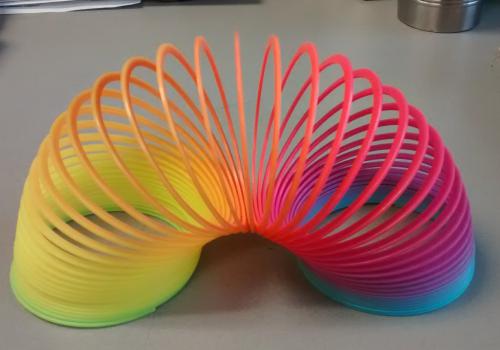The shape of science
Discover how cool and interesting science can be.

Have you ever taken the time to think about science? Most people have not, but if they did they might be surprised to find science is very interesting and fun. What they would discover is that science is a process. It has a progression of seven steps:
- Ask a question (I wonder...)
- Research (I search, investigate...)
- Hypothesis (I predict...)
- Experiment (I try, do...)
- Collect data (I observe, measure...)
- Explain data (I interpret, tell...)
- Ask new questions (I wonder...)
As a visual and hands-on learner, this description only gets me so far. If I am going to really understand this process, I need a model I can see and touch, and Photo 1 is that model. The process of science, modeled as a climbing vine, is living, growing, expanding and adapting. It is rooted in the past, but extends into the present and future. It starts with wonder and comes back to wonder with lots of exploration and discovery in between. It is a model of how we learn.
Thinking about and playing with this model allows us to discover even more about science itself. If you look at the climbing vine and the first leaf (ask a question) and the seventh leaf (ask new questions), you begin to see a shape of a coil or spring—a spiral. New questions are built on the older questions and all the research, experimenting and discovery that came with the first question. As more questions are asked, we build our knowledge and understanding. So, science has a shape! How cool is that?

Exploring this with kids can be problematic, however. For most kids, spiral is not a normal word in their vocabulary until late elementary, middle or even high school. An example or analogy that is more familiar to kids is a slinky, a toy that when placed on the top step of a stairway and given a little push, will “walk” down the steps.
This discovery, that science has a shape, gives us all a new way to look at science, a new appreciation and connection to how cool and interesting science can be.
If you think about and examine the process of the science model just a little bit further, there are other interesting questions you can ask about science.
- What color is science?
- What is the sound of science?
- What type of fertilizer should we give science to keep it growing?
- What type of support does science need?
- How long will science grow?
Suddenly, science has new meaning and connections. It starts to come alive. If you look just under the surface, you see that science is part of everything we do. It is part of our daily lives.
Science has a shape, a spiral or slinky that builds knowledge on what we already know. It grows. It is pretty cool and interesting. We should tell everyone about the shape of science and how cool and interesting science is.
Let’s celebrate science!
Michigan State University Extension and the Michigan 4-H Youth Development program help to create a community excited about STEM (Science, Technology, Engineering, and Mathematics). 4-H STEM programming seeks to increase science literacy, introducing youth to the experiential learning process that helps them to build problem-solving, critical-thinking and decision-making skills. Youth who participate in 4-H STEM are better equipped with critical life skills necessary for future success.
To learn more about MSU Extension, visit the MSU Extension website. For more ways to share science with youth in your life, please explore the MSU Extension Science and Engineering website. For more information about 4-H learning opportunities and other 4-H programs, contact your local MSU Extension office.
The Michigan 4-H Children’s Garden is funded through the Michigan 4-H Foundation.



 Print
Print Email
Email





